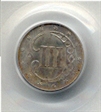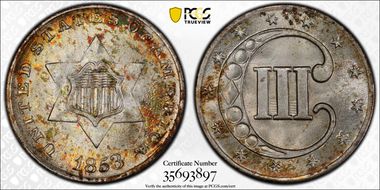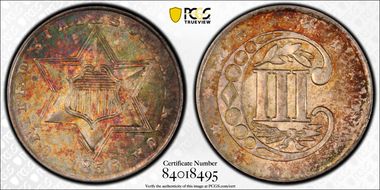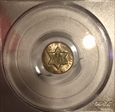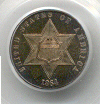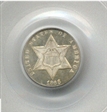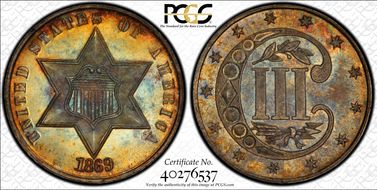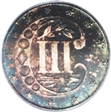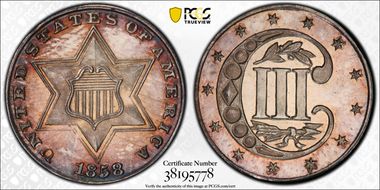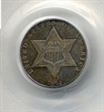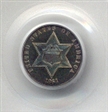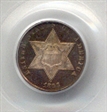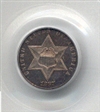Magic Starr Collection - SCARSDALE COIN 的钱币相册
CAC 1851 3CS MS67 PCGS. CAC. An impressive first-year type coin, sharply struck from unlapped dies. Each side glows with creamy-white satin luster, devoid of bothersome abrasions. Among the finest pieces certified, and a rarity in this grade with CAC endorsement. Population: 32 in 67 (5 in 67+), 0 finer. CAC: 11 in 67, 0 finer (4/21).
CAC Currently the PCGS Pop report shows 8 certified 1851-O in MS66, however this is not truly correct as this example had been submitted 4 times in hope of reaching 67 status….by todays current standards the 67 designation would easily be attainable!
CAC Fluorescent blues, greens, and oranges stand out on the surfaces of this very attractive piece
CAC 1853 Three Cent Silver, MS67 One of the Finest Certified Survivors 1853 3CS MS67 PCGS Secure. CAC. This original Type One Superb Gem is essentially unmarked and displays a bold strike on the design features. Mottled blue and russet patina adheres mainly to the peripheral areas. Faint clash marks from the shield are apparent within the bars of the denomination. Among the finest survivors from this early issue in the series. Population: 14 in 67 (3 in 67+), 0 finer. CAC: 12 in 67, 0 finer (6/18).(Registry values: N2998) Coin Index Numbers: (NGC ID# 22Z2, PCGS# 3667, Greysheet# 3620)
CAC First year of the Type Two design and one of the most challenging issues in the series, especially in Gem condition. This piece has a remarkably strong strike for the type (except, of course, on the reverse stars), and the mint luster is full and frosted. Each side has pale ice-blue patina with an irregular overlay of golden/brown patina. A couple of horizontal die cracks are seen on the obverse and there is just the slightest evidence of the clashing in the fileds (normally a very pronounced feature on three cent silver pieces.) Pedigree From the Robert Bowling Collection
CAC This is a stunning example of a terribly undervalued coin. Exquisite surfaces are flawless. Even using a strong glass there is nothing to find. The luster is moderate due to the heavy toning. Both sides have a wonderful deep but totally original mix of navy/magenta/golden brown colors. Every detail is actually needle sharp in strike. The eye appeal is pretty neat! PCGS 3, NGC 5, CAC 3. PCGS has possibly graded 3 higher. The last auction appearance of one of these was back in July 2015. That coin brought $15,275. Today the PCGS CAC price guide shows $14,400. We can tell you, you will never have many opportunities to buy a higher grade 1856 MS 3CS. Good luck! Cert. Number 84018495 PCGS # 3672.00
CAC Golden hues on the obverse make this little trime very attractive, a very pq original example!
An attractive uncirculated example of a 1860 Three Cent Silver piece, with excellent eye-appeal for the grade. The obverse is splashed in violet and blue iridescence while the balance of this satiny example exhibits only traces of russet peripheral toning
CAC FROM THE IPSWICH COLLECTION. This coin borders sheer perfection. Proof like mirrors do beam vividly from all over. The mirrors are clean, smooth, and offer a strong reflection. Both sides are evenly covered by an original and moderate to deeper mix of purple/magenta/evergreen/olive/navy colors. Every detail is sharply struck and has thick frost. If this coin were just slight lighter in color, we could see it grade as high as MS67! The eye appeal is just fine. PCGS 22, NGC 13, CAC 8. The last PCGS CAC piece to sell brought $7,050 in August 2017. We assure you, this piece will please the pickiest! Cert. Number 34347911 PCGS # 3682
Gold CAC Sharply struck gem of the highest order, somewhat prooflike in appearance, richly toned. Obverse shield is deep iridescent gold, surrounding fields display iridescent violet and sea green. The reverse displays deep iridescent blue at the center that spreads outwards through shades of rose and gold
CAC Rich, golden russet with touches of green and blue! Dazzling Mint Frost!!!
CAC ELIASBERG PEDIGREE - One of the few business strikes produced and much rarer than the proofs of this date. This is simply a gorgeous coin. The fields are brightly lustrous, very interesting and prominent die clashing evident on both sides, One of the finest business strikes known of this rare issue and a superlative example.
Gold CAC Awesome blues and reds stand out on this gorgeous piece! Only 4,000 minted. Pedigree William Wasler Collection
CAC OGH An exceptional piece with fairly even, moderate toning with great luster showing through. Housed in a old PCGS green holder!
1869/'8' 3CS MS67+ PCGS. CAC. Pedigree Ex: Simpson. The 1869-dated three cent silver pieces from these dies are traditionally called overdates. However, some observers have questioned the true nature of the variety, suggesting that it is either a recut 1869/9, or the result of a die line inside the digit. According to PCGS Coin Facts, this is the only Mint State example that is identified as the "overdate" variety, while 11 proof examples carry the same identification. Regardless of its name, the fact is that this is the second finest PCGS-certified Mint State 1869 three cent piece of any variety. A sharply struck Superb Gem, this piece has brilliant satin luster beneath blue central toning with a ring of gold and iridescent toning, nicely matched on each side. Population: 1 in 67 (1 in 67+), 0 finer. CAC: 1 in 67, 0 finer (1/21).
A spectacular prooflike Gem example. Sharply struck and vividly toned, especially on the reverse, in electric hues of gold, blue, and pink. A desirable low-mintage issue. A mere 4,360 trimes were minted in 1871, with proofs accounting for 960 pieces. Today, Gem business strikes are much scarcer than proofs and sell for substantially higher premiums in corresponding grades of preservation.
The sale of proof coins to the general public did not begin until 1858. While proof Trimes exist in most years prior to 1858, their mintage was miniscule. Although the proof mintage for 1858 Three Cent Silvers is unknown, it was decidedly very low. Surprisingly, two varieties are known, one with a repunched 5 in the date, and the second with die lines (as minted) above TED in UNITED. This rare and untoned representative is from the second variety. It has a strike that is complete except for the details of a couple of the reverse stars. The mirrored fields lack contrast with the devices, but have good reflectivity. A few hairlines on both sides do not interfere with the appeal of this desirable, rare proof specimen.
Probably the finest 1856 you''ll ever see, this little gem came from an 1856 proof set! Hows that for a pedigree!
Very difficult to locate so choice (the pops are incorrect for this date) Sleek, silvery, and boldly reflective mirrors burst from both sides. All of the details are sharply struck and have thick frost. The eye appeal is pretty and flashy!
Reflective fields and frosted motifs show rich gold and violet iridescence, especially so at the rims. Sharp and appealing, a near-pristine gem of a high order. PCGS has not certified a Proof example of the date at a finer grade, making the present specimen even more appealing!
This richly toned, mostly golden-russet example reveals deep reflectivity as the coin turns into the light. Certain angles also allow appreciation of the deeply frosted devices yielding the pronounced cameo effect of often coveted by collectors. Fully struck and free of distracting hairlines!
An incredible cameo coin that traces back to the owner of a small coin shop that had stuck it away many decades ago!
A very flashy, glassy mirrored Gem proof, this piece displays deep cobalt-blue toning over most of each side with lighter, occasional accents of golden and rose color. A very impressive proof whose depth of toning does not obscure the underlying brightness of the proof mirrors.
This is an absolutely gorgeous Trime with glittering fields and well frosted devices. Bold contrast is evident beneath warm crimson-champagne iridescence. Only 4,360 Three Cent Silvers were produced in 1871, 960 pieces of which were proofs. To date, this is only the second proof 1871 certified as Cameo by PCGS, the other grading only PR64
1872 3CS PR66 Cameo PCGS. Using a single set of dies, the Philadelphia Mint delivered 1,000 business strike and 950 proof Three Cent Silvers in 1872. Since representatives of the first group do not turn up with any degree of regularity, extant specimen strikings are prized among date collectors. Whereas some proof 1872 Trimes in today's market are impaired, the present Gem is free of bothersome post-production impairments. Glassy in the fields, both sides are also suitably well frosted over the devices. A few small planchet flaws and strike throughs (both as struck) are noted.





















